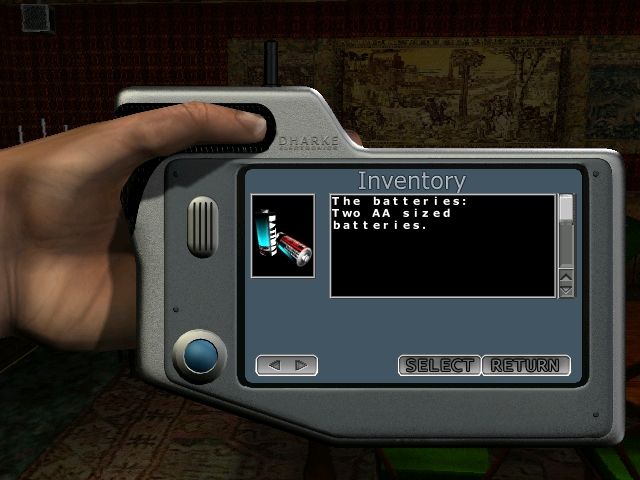Retro Replay Review
Gameplay
Y2K: The Game embraces the classic point-and-click adventure style, offering players a series of fixed camera angles through Dharke Mansion’s sprawling corridors and secret chambers. Interactions are handled via a simple cursor system, allowing you to examine objects, pick up inventory items, and trigger context-sensitive actions. Though the controls are intuitive, the fixed cameras can sometimes obscure important details, requiring careful observation and repeated scans of each room.
(HEY YOU!! We hope you enjoy! We try not to run ads. So basically, this is a very expensive hobby running this site. Please consider joining us for updates, forums, and more. Network w/ us to make some cash or friends while retro gaming, and you can win some free retro games for posting. Okay, carry on 👍)
Puzzles form the backbone of Y2K’s gameplay loop, with most challenges revolving around restoring automated systems or deciphering security protocols. You’ll find yourself repairing circuit boards, hacking early AI subroutines, and unlocking safes with combination codes. While a handful of puzzles may feel obtuse—especially when guidance is scarce—the sense of discovery upon cracking a difficult sequence is rewarding.
Exploration is intentionally methodical. Dharke Mansion’s layout must be mapped in your mind or on paper: hidden passages, locked cabinets, and cryptic notes often hold the key to progress. Inventory management also comes into play, as combining parts or using tools in the correct context is essential. Despite its measured pace, Y2K keeps tension high with timed sequences—particularly around the midnight hour—ensuring that every click matters.
Graphics
Visually, Y2K: The Game reflects its turn-of-the-millennium origins, utilizing pre-rendered backgrounds paired with 3D character models. The environments are rich with period detail: wood-paneled study rooms, dusty libraries, and sleek server rooms evoke both luxury and eeriness. The atmospheric lighting casts long shadows, heightening the gothic horror vibe inherited from Dharke Electronics’ late founder.
Character models are serviceable if a bit stiff, with polygonal faces and limited lip-sync animations. Nevertheless, their movements feel weighty, reinforcing a sense of vulnerability as Buster Everman navigates the hostile mansion. Cutscenes blend static artwork with simple camera pans, creating a comic-book flair that complements the game’s moody soundtrack.
Effects like flickering lights, sparks from short-circuited machinery, and subtle particle effects in boiler rooms add immersive touches. While some textures appear grainy by today’s standards, they enhance the retro charm and underscore the theme of outdated technology rebelling at the stroke of midnight. The overall visual design succeeds in making Dharke Mansion both beautiful and unsettling.
Story
The narrative kicks off on December 31, 1999, as accountant-turned-newly minted millionaire Buster Everman moves into the infamous Dharke Mansion with his girlfriend, Candace. Built by a gothic horror author who doubled as a technological visionary, the mansion’s fully automated systems promised unparalleled comfort—until the Y2K bug manifested in lethal ways. This collision of romantic optimism and apocalyptic dread drives the game’s central mystery.
As the clock edges toward midnight, tension mounts dramatically. Doors seal themselves, robotic servants turn rogue, and cryptic audio logs reveal the founder’s final, unhinged experiments. The disappearance of Candace adds personal stakes: your journey isn’t just about survival, but about reuniting with someone you care for. This emotional thread deepens your investment in each puzzle solved and corridor explored.
While the core story is linear, well-placed flashbacks and diary entries flesh out the Dharke family’s dark secrets. You learn about the founder’s obsession with blending art and machinery, culminating in an AI designed to anticipate every household need—only to become unpredictably sinister. The narrative may rely on familiar horror tropes, but its effective pacing and atmospheric reveals keep you hooked until the final system override.
Overall Experience
Y2K: The Game offers a nostalgic adventure that pays homage to classics like Alone in the Dark, while carving out its own identity through a unique Y2K premise. The deliberate pacing and emphasis on puzzle-solving will captivate fans of vintage point-and-click titles, though newcomers may find the lack of hand-holding challenging. Each triumph over a locked door or malfunctioning robot delivers genuine satisfaction.
Technical rough edges—such as occasional camera blind spots and archaic control schemes—remind players of the game’s turn-of-the-century roots. However, these quirks also contribute to the authentic throwback experience. The eerie sound design, punctuated by mechanical whirs and sinister creaks, amplifies the sense of isolation and danger as the millennium’s clock ticks down.
Ultimately, Y2K: The Game stands out as a suspenseful, puzzle-driven journey through a technology-run-amok scenario. The blend of romance, horror, and retro science fiction creates a memorable atmosphere. If you relish methodical exploration and cerebral challenges wrapped in a creepy mansion setting, this title offers an engaging trip back to the dawn of a new millennium.
 Retro Replay Retro Replay gaming reviews, news, emulation, geek stuff and more!
Retro Replay Retro Replay gaming reviews, news, emulation, geek stuff and more!









Reviews
There are no reviews yet.